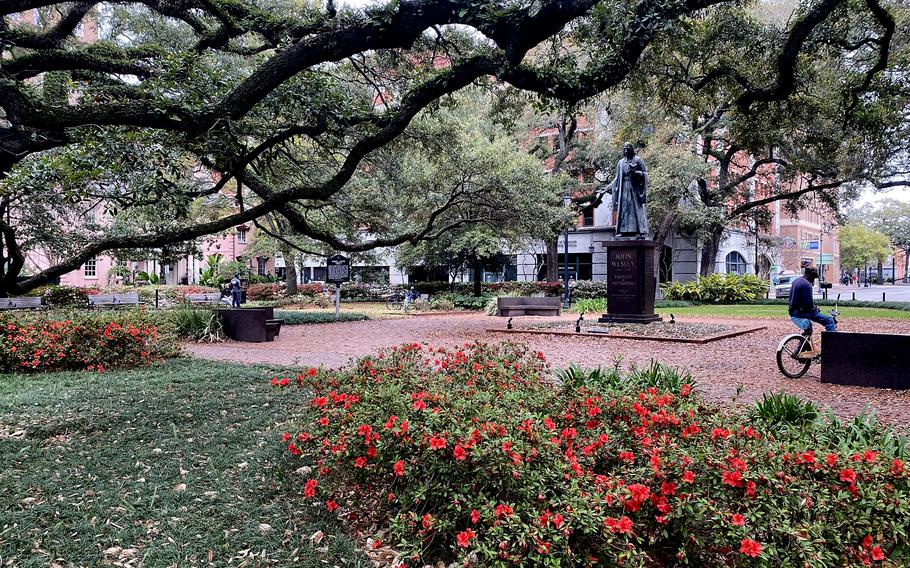
A monument to John Wesley, who lived briefly in Savannah, Ga., before he helped found the Methodist Church, anchors Reynolds Square. (Alex Pulaski/For The Washington Post)
In his mind’s eye, author John Berendt can still conjure up his first glimpse of Savannah, driving southwest from Charleston over the Talmadge Memorial Bridge, seeing a patchwork of greens and browns, with church steeples and rooftops peeking through the dense tree canopy.
That initial intoxicating visit led to eight years of on-again, off-again residency. Berendt, a New York magazine writer and editor, found himself “beguiled by Savannah,” and between the city’s historical houses and a cast of captivating characters, he calculated that he had enough material to populate a book. He called it “Midnight in the Garden of Good and Evil” and hoped for modest success when it debuted in 1994.
Instead, it leaped atop bestseller lists and stayed there for more than four years. Its presence lingers in Savannah still, as real as the spring dogwood and azalea blossoms in the city squares.
One of “Midnight’s” recurring themes is that the city’s residents are impervious to outside influence and stubbornly resistant to change. “Savannah was invariably gracious to strangers, but it was immune to their charms,” Berendt wrote in the afterword. “It wanted nothing so much as to be left alone.”
Fast-forward to 2022. For a quarter-century, millions of tourists - many inspired by reading Berendt’s prose - have besieged Savannah. The city’s port and economy are booming, and progress hangs like pollen in the air. A new $375 million riverfront hotel and entertainment complex called the Plant Riverside District stands atop a project list transforming modern Savannah.
“I’m amazed at the amount of change that has occurred since I came here in 1992,” said Bridget Lidy, the city’s director of planning and urban design.
While recognizing tourism as a primary economic driver - valued at about $3.1 billion in 2019 - the city is striving to keep visitors from strangling the city’s historical character and driving the locals to drink. Savannah is notorious for its affinity for cocktails, and the options continue to multiply with every new restaurant or rooftop bar atop a chic hotel.
Warning signs about the conflict between new and old are as apparent as the construction cranes: In 2018, the National Park Service categorized Savannah’s National Historic Landmark District as “threatened.” Although the dial hasn’t moved in four years, Lidy says the city and partners are planning a detailed response while simultaneously implementing a tourism management plan designed to balance commerce, historical preservation and quality of life.
A chance lunch conversation in early 2019 led to Berendt’s book (I confess, I was late to the party) and cast Savannah’s spell on me. I planned a visit this March (delayed two years by the pandemic) with my wife, Mica. The week before, I reached the author by phone.
Berendt was visiting Mérida, Mexico, and although he maintains phone ties to Savannah, he has not been there in years. He hears rumblings. Worries that outsiders - the “Gucci carpetbaggers,” described by one of the book’s characters - are overrunning the city.
“I think it would be a very interesting study to see what has changed there, what has remained of the standoffishness of Savannah,” he told me. “A lot of people there now were not there when the book came out. I’m curious.”
I was curious, too. The book’s voodoo priestess warns against the reverberations of intent, deed and especially timing. I wondered: Where do the clock’s hands stand in Savannah? How is its dynamic present meshing with a palpable past?
Savannah’s European settlement dates to February 1733, when an English prison reformer led some 114 colonists to a bluff overlooking the Savannah River. King George II had dispatched James Edward Oglethorpe to establish Georgia in his name, in part as a buffer between Spanish-controlled Florida and the prosperous English colony of South Carolina.
As colonists’ initial plans to establish a silk-production industry stalled, rice succeeded as a staple crop. Savannah’s newfound wealth exacted an enormous human toll, however: Rice planters, eager for cheap labor, helped overturn the founding trustees’ original ban on slavery by the 1750s.
In the succeeding decades, large-scale cotton cultivation allowed Savannah to become one of the Atlantic seaboard’s leading cotton ports. The trade in enslaved people thrived.
“They sold people on the steps of the courthouse for 75 years,” said historian Vaughnette Goode-Walker, who leads modern-day tours about the city’s enslaved person and cotton trades. “The slave brokers were also bankers. You had to have money to buy people.”
One of Savannah’s wealthiest enslaved person traders and bankers commissioned the English Regency-style home now known as the Owens-Thomas House & Slave Quarters. During the 1820s, Richard Richardson’s firm engaged as many as five ships to transport enslaved people in the lucrative interstate market.
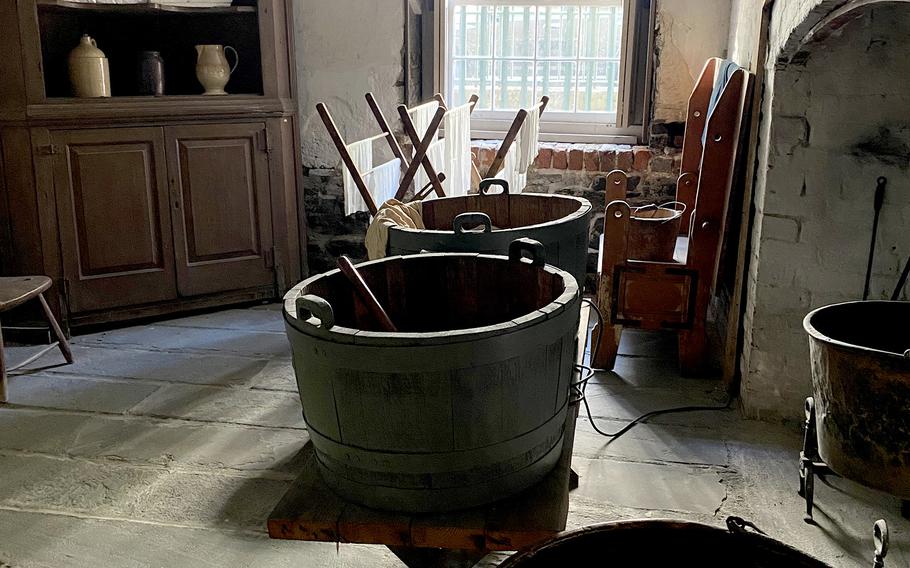
The Owens-Thomas House & Slave Quarters emphasizes the story of the enslaved people who worked in the home. (Alex Pulaski/For The Washington Post)
Of the many historical-house tours offered in Savannah, Owens-Thomas is notable for its frank depiction of how enslaved people lived and were treated. Tours begin in the carriage house; a wall near enslaved people’s quarters bears the names of dozens of people Richardson had shipped from Savannah to New Orleans.
The city’s oldest surviving buildings date to the 1700s. Architectural guide Jonathan Stalcup led a group of us on a walking tour through the decades, up to the 1950s, when a concerted effort took root to save historical buildings from the wrecking ball.
Among them stands the 17-room Hamilton-Turner Inn, which dates to 1873. It was destined to be razed in 1965 to make way for a playground until the Historic Savannah Foundation intervened. We spent two nights there and found it to be a lovingly restored picture of grace, from the chandeliers to marble fireplaces to period wallpaper.
My wife and I also took in the tours at many of the historical homes, among them the stately Green-Meldrim House, which Gen. William T. Sherman used as his headquarters after city fathers negotiated Savannah’s surrender in the Civil War’s waning months.
Other houses we toured included the marvelously furnished Harper Fowlkes House; the elegant Andrew Low House Museum; and the Mercer Williams House Museum, which sits center stage in “Midnight” as the main character’s home, on lovely Monterey Square.
When Oglethorpe designed the town, for defensive reasons he directed that it be laid out in wards, each with a central square. The squares eventually numbered 24, and the 22 that survive are what make Savannah unique.
Each square bears a name, and although details vary, they tend to share common traits of stately live oaks, often draped with delicate Spanish moss. Today, they are home to monuments and fountains and benches, to children racing and couples slowly savoring the sights.
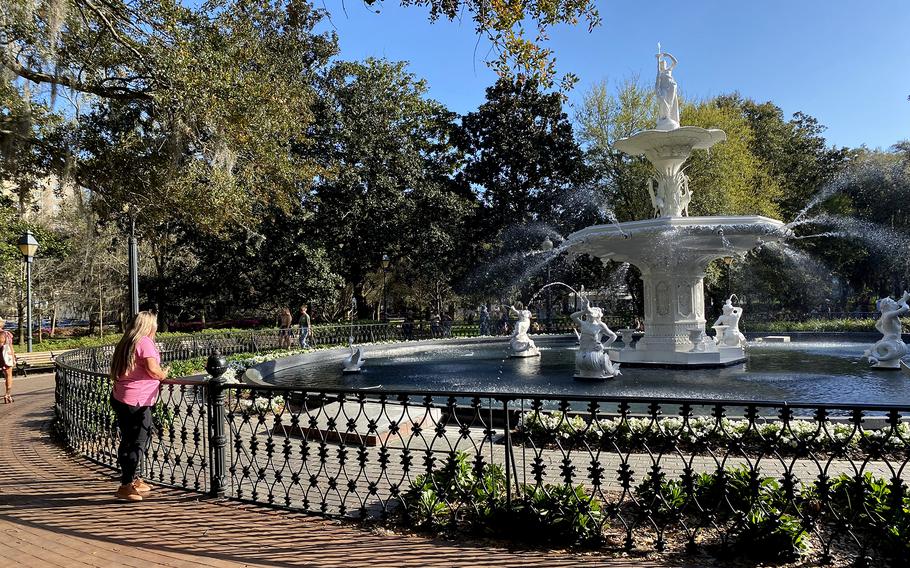
Forsyth Park is home to a fountain that was installed in 1858. (Alex Pulaski/For The Washington Post)
“I like that you can walk wherever you want and you feel safe,” said Angela Fischer-Sussner of Marshall, Minn. “We go where the spirit leads us, and when you want to, you just sit down and watch the world go by.”
If the new Savannah holds a common vantage point, you’ll probably find it, as we did, from the rooftop bar of a new crop of high-end hotels.
From Bar Julian atop the Thompson Savannah, which opened in August 2021, the view encompasses the Savannah River and the graceful outlines of the Talmadge bridge. In the heart of the historic district perches Peregrin at the Perry Lane Hotel, which debuted in June 2018.
Sitting pretty among these debutantes are not one but four rooftop bars at the massive Plant Riverside District, which opened in July 2020 and has already garnered national and regional planning awards. The development includes a riverfront promenade, more than a dozen eateries, live music venues, fountains, shops, art galleries and the visual wallop of chrome-dipped model dinosaur fossils dominating the lobby of the elegant hotel.
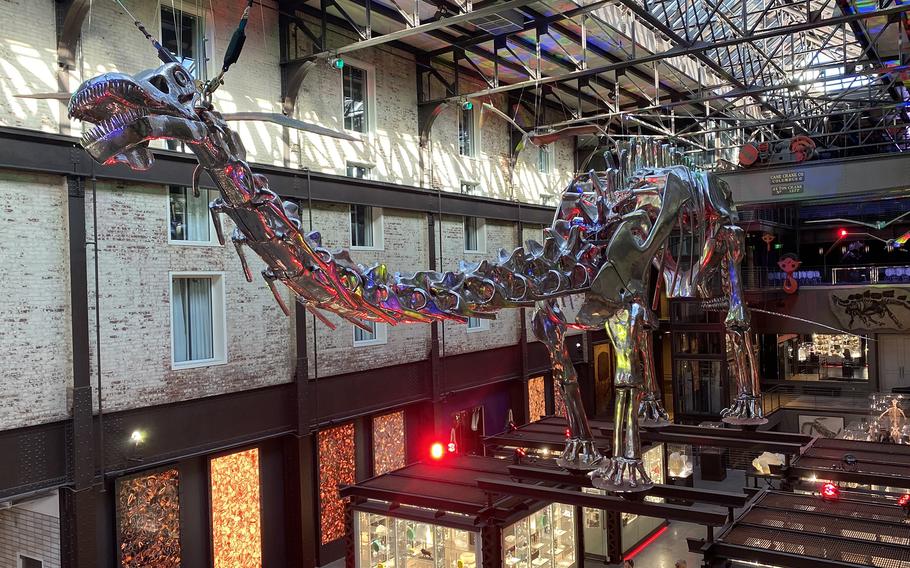
Chrome-dipped model dinosaur fossils dominate the interior of the JW Marriott Savannah Plant Riverside District. (Alex Pulaski/For The Washington Post)
A little over a decade ago, all of this was an eyesore - an abandoned electric power plant approaching a melancholic 100th birthday. From the vantage point of his rooftop bar a few blocks away at the Bohemian Hotel Savannah Riverfront, hometown developer Richard Kessler saw the renewal possibilities.
“Savannah was about history - but that’s all it was about,” Kessler said. “After the kids go through three or four historic homes, they’re saying, ‘Do we have to see another?’ I wanted to make the focus music and art.”
On a Sunday afternoon, we joined the rippling current of walkers on the district’s wide brick promenade. Many appeared to be locals, and others, including us, were adding to the tourist trade. Tourism numbers have roughly tripled over the past quarter-century, to 14.8 million visitors in 2019.
We were experiencing something old made new again - much as James Beard Award-winning chef Mashama Bailey has done at the Grey restaurant, set in a restored 1938 art deco Greyhound bus terminal. Or in the farm-fresh fare served at Common Thread, which opened in January 2021, set in a home dating to 1897.
In many respects, Kessler embodies what local civic leaders describe as modern Savannah’s approach to planning, in which progress and preservation are not mutually exclusive. He has developed seven hotels in the historic district, and counts his credo as: “Always leave it better than you found it.”
Amid all this change, there’s something comforting about those places that appear to hold time at bay. Among them are Clary’s Cafe, one of the touchstones of Berendt’s book, where the menu, music and even the prices seem to be standing still.
Or Leopold’s Ice Cream, where the lines often run 40 deep outside the door by midafternoon. The formula for success hasn’t changed since its 1919 opening.
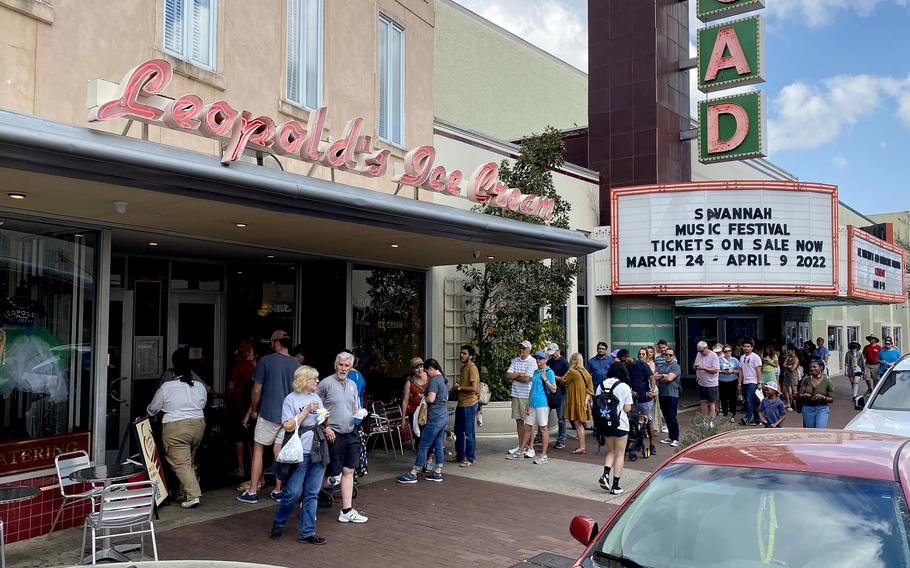
Leopold’s Ice Cream opened in 1919, and its formula for success hasn’t changed since. (Alex Pulaski/For The Washington Post)
“It’s my dad’s recipes,” Stratton Leopold told me. “I grew up behind that soda fountain.”
Or Mrs. Wilkes’ Dining Room, a boardinghouse that has been serving melt-in-your-mouth Southern comfort food since the 1940s. Sema Wilkes’s granddaughter, Marcia Thompson, enlisted her own grandkids to work during the pandemic to fill staff shortages.
“We had lines down the block,” Thompson said. “All these young upwardly mobile people from New York and the Midwest, and they all wanted to move to Savannah.”
She laughed, remembering.
“I just love working here,” she said. “One day, when I’m gone, my kids will sell this place, but I won’t be here, so I’ll never know.”
True enough, but the dead still speak their lines on Savannah’s stage. Amid the weathered gravestones and mossy oaks of Bonaventure Cemetery, stone angels keep a silent vigil. Berendt calls this place “the most sublimely beautiful place in America,” and it’s hard to argue the point from atop a bench.
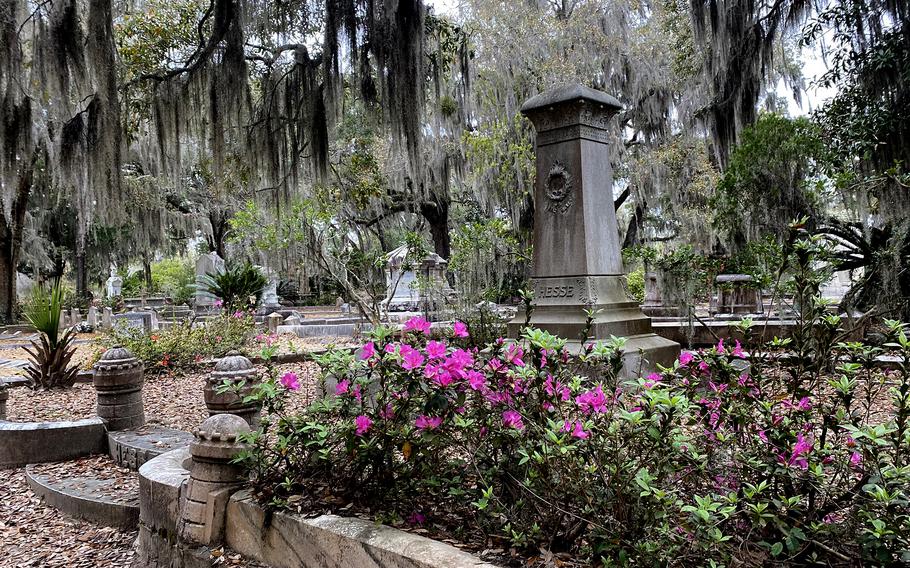
Bonaventure Cemetery, which author John Berendt calls “the most sublimely beautiful place in America.” (Alex Pulaski/For The Washington Post)
One pays tribute to native son Johnny Mercer’s resting place, its surface engraved with his most famous songs, such as “Moon River,” for which he wrote the lyrics. On another bench, Savannah-born poet Conrad Aiken’s name is accompanied by the words: “Cosmos Mariner Destination Unknown.”
As “Midnight” recounts, Aiken had seen a ship passing through Savannah called Cosmos Mariner and had been enamored with its name and unknown destination contained in a port registry.
Sitting there, appreciating Aiken’s wry assessment of his own uncertain celestial navigation, I wondered what he would make of his hometown’s road map from past to present to future. He once wrote, “All lovely things will fade and die,” and described autumn rains chasing spring’s flowers.
Keeping Savannah in bloom remains the province of its gardeners, among them the city planning department’s Lidy, who first moved here 30 years ago.
“I’m still here because I feel I can leave my fingerprint,” she said. “There are still opportunities to do good things here.”
IF YOU GO:
Where to Stay
JW Marriott Savannah Plant Riverside District
400 W. River St.
912-373-9100
Wonderfully transformed from a shuttered power plant to a vibrant hotel, dining and entertainment destination. Rooms have modern touches but maintain a link to the past through exposed steel beams and brickwork. Rooms from about $290.
Hamilton-Turner Inn
330 Abercorn St.
912-233-1833
This delightful 17-room inn, which received a mention in John Berendt’s “Midnight in the Garden of Good and Evil,” has come full circle, from ornate home to neglected space to restored beauty. It has rightfully earned a spot in best-of lists, and with a window onto Lafayette Square, it transports visitors to another time. Rooms from $249.
Where to Eat
Mrs. Wilkes’ Dining Room
107 W. Jones St.
Lines for this lunch-only spot typically stretch down the block, with good reason. The parade of family-style dishes has to be seen - and tasted - to be believed: fried chicken, black-eyed peas, sweet potato souffle and more. Open Monday to Friday, 11 a.m. to 2 p.m. Cost is $30 per person, tax included. Credit cards not accepted.
Common Thread
122 E. 37th St.
912-944-7482
Pair a modern menu with a beautifully restored old house. Dinner entrees, such as the short rib and pork collar, are spectacular. We sat in the bar rather than the main dining room, and bartender Bonnie Wallace and bar manager James Nowicki turned a great dinner into a festive feast. Open Sunday to Thursday, 5 to 9 p.m., and Friday and Saturday, 5 to 10 p.m. Entrees start at $18.
The Grey
109 Martin Luther King Jr. Blvd.
912-662-5999
This restaurant is set in a renovated 1938 art deco Greyhound bus terminal, highlighting the soulful recipes of chef Mashama Bailey. Open Wednesday to Saturday, 5 to 10 p.m., and Sunday, 11 a.m. to 3 p.m. The three-course dinner is $75 per person.
Local 11ten
1110 Bull St.
912-790-9000
A modern, bustling place where the fresh ingredients, especially the seafood, shine. Standouts include market crudo of thinly sliced red snapper, and pan-seared halibut in a tarragon white wine sauce. Open Wednesday and Thursday, 5:30 to 9 p.m.; Friday and Saturday, 5:30 to 9:30 p.m.; and Sunday, 5:30 to 9 p.m. Entrees start at $28.
Clary’s Cafe
404 Abercorn St.
912-233-0402
From what I gather, not much has changed here since Berendt memorialized the place in “Midnight” (other than the stained-glass homage to the book). Cheerful service and simple, hearty fare at remarkably low prices. Open daily, 8 a.m. to 2 p.m. Entrees start at about $7.
Stone & Webster Chophouse
500 W. River St.
912-373-9066
One of the dozen-plus spots to grab a bite at the Plant Riverside District, this casual-but-upscale eatery specializes in hearty cuts of meat, such as an aged filet mignon or a tender Berkshire pork chop. Open Tuesday to Thursday, 5 to 10 p.m., and Friday and Saturday, 5 to 11 p.m. Entrees start at $42.
What to Do
Architectural Tours of Savannah
912-604-6354
Guide Jonathan Stalcup takes small groups on a journey from the 1730s, when Savannah was founded, to the 1950s, when efforts to save the city’s buildings took root. He explains the city’s layout and dissects historical buildings. Tours run once a day, usually at 10 a.m. Tours $30 per person.
Footprints of Savannah Walking Tours
912-695-3872
Historian Vaughnette Goode-Walker starts her tours by thanking the ancestors, then takes listeners on a sobering journey through the city’s history in the enslaved person and cotton trades. She shows copies of ship manifests and receipts for sold enslaved people, and ends up at a building constructed as an enslaved person mart in the 1850s. Tour typically starts at 10 a.m.; 9:30 a.m. during summer. Costs $25 per adult; $10 for children under 12.
Owens-Thomas House & Slave Quarters
124 Abercorn St.
912-790-8800
Tours offer a frank view of how enslaved servants lived and were treated for about the first half-century of this home’s history. Open daily, 10 a.m. to 5 p.m. Last tour begins at 4:15 p.m. Tickets $22 for adults, $20 for seniors and active military, $15 for students, $5 for children 6 to 12, and free for children 5 and under; includes entry to the Jepson Center and Telfair Academy.
Mercer Williams House Museum
429 Bull St.
912-238-0208
Packed with relics collected by Jim Williams, the main character in “Midnight,” this well-preserved house is a must-see for the book’s fans. It is also the place where Williams and the man whose killing he was acquitted of - after four trials - breathed their last. Open Monday to Saturday, 10 a.m. to 5 p.m., and Sunday, 11:30 a.m. to 4:45 p.m. Tickets $12.50 for adults, $8 for students and active military, and free for children 7 and under.
Bonaventure Cemetery
330 Bonaventure Rd.
912-651-6843
Characters in Berendt’s book often made their graveyard visits in the dead of night. Although I can only imagine how creepy it would be in the moonlight, Bonaventure is strikingly beautiful and peaceful in the daytime. Open daily, 8 a.m. to 5 p.m. Free.
Information: visitsavannah.com